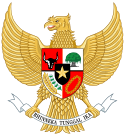Wybory parlamentarne w Indonezji w 1987 roku
Wybory parlamentarne w Indonezji w 1987 roku odbyły się 23 kwietnia. Były to czwarte wybory zorganizowane w kraju po przejęciu władzy przez gen. Suharto (piąte w historii niepodległej Indonezji po wyborach z 1955, 1971, 1977 oraz 1982 roku). Po przeprowadzonych zmiananach, do zdobycia w wyborach było 400 mandatów (na pięcioletnią kadencję) w liczącej 500 miejsc Izbie Reprezentantów. Pozostałe 100 miejsc było zarezerwowane dla przedstawicieli armii (wojskowi nie posiadali czynnego prawa wyborczego) oraz osób wydelegowanych przez Suharto[1].
Wyniki
| Ugrupowania[2] | Liczba głosów | % | Liczba mandatów |
|---|---|---|---|
| Golkar | 62 783 680 | 73,11 | 299 |
| Zjednoczona Partia na rzecz Rozwoju | 13 701 428 | 15,96 | 61 |
| Indonezyjska Partia Demokratyczna | 9 384 708 | 10,93 | 40 |
| Łącznie | 85 869 816 | 100% | 400 |
Przypisy
- ↑ H. Tjan Silalahi, The 1987 election in Indonesia, Southeast Asian Affairs 1988, str 97.
- ↑ Indonesia elections 1987. [dostęp 2017-03-18]. (ang.).
Media użyte na tej stronie
State emblem of Indonesia is called Garuda Pancasila. The main part of the coat of arms is the golden mythical bird Garuda with a shield on its chest and a scroll gripped by its leg bears the national motto: "Bhinneka Tunggal Ika", roughly means "Unity in Diversity". The shield's five emblems represent Pancasila, the five principles of Indonesia's national philosophy. The numbers of feathers was meant to symbolize the date of Indonesian Proclamation of Independence; 17 feathers on each wings, 8 tail feathers, 19 upper tail feathers (under the shield, above the tail), and 45 neck feathers; all symbolize 17-8-1945; 17th August 1945. Garuda Pancasila was designed by Sultan Hamid II of Pontianak, and was adopted as national coat of arms on February 11, 1950.

